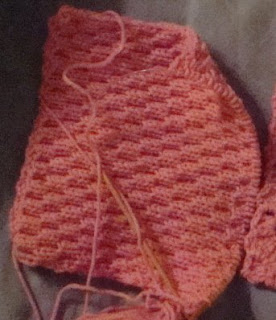Lately I have taken it into my head to design a circular shawl. Since I've never actually knit a circular shawl before, I've been studying other people's to get a general idea of 1) how much to increase and 2) how to incorporate increases into the design (I have a fairly good general idea of what I want the design to be). So I've looked at
A Gathering of Lace and the
Modern Lace Knitting books, as well as the designs of Lace Grandmaster
MMario (Ravelry link: if you're on Ravelry, you have to see this man's work).
#1 has led me to spend some time pondering the math of circles. Consider a circle with a radius of 1 (1 what doesn't matter: cm, inch, smoot, whatever you like — except if you're knitting a circle with a 1-smoot radius, I can only say, rather you than me). If I knit round and round on that circle, what will the radius be when the circle's circumference has doubled? Well, the circumference, as we know, is 2
πr, so, 2 and
π being constants, the circumference will double when the radius does. The area of the circle, however, is
πr
2, so the original circle has an area of
π, and it will have an area of 2
π when the radius is the square root of 2, or about 1.4. So I had best make sure to have plenty of yarn.
Another way of looking at it is to consider a regular hexagon, which is closely related to a circle. (If you draw a circle with a compass, then pick up the point of the compass, put it on a point on the circle, and draw an arc intersecting with the circle, then put the point of the compass on the intersection and draw another arc, and so on around the circle, and then connect all those intersections with straight lines, you will have a regular hexagon.)

If you double the radius of a regular hexagon* (I'm not sure if hexagons technically have radii, but you know what I mean), the circumference will also double, but the area will triple. Tripling the radius will multiply the area by five, quadrupling it will multiply the area by seven, and so on. Grant and I, mostly Grant, at one point proved that these ratios hold true for circles as well, but I don't remember exactly how; it has to do with the fact that the difference between the squares of positive integers n and n+1 is 2n+1. (Grant also proved that just for the fun of it, and I might be able to again if I thought about it. But back to knitting.)
Update: Before any of you engineering types get to pointing this out, (n+1)
2, or (n+1)(n+1), is (using the FOIL mnemonic I learned in school, for first, outer, inner, last — see, Mr. Gibbons? at least one thing actually stuck) n
2+n+n+1, or n
2+2n+1. QED.
In any event, the question is how to increase the stitches in a reasonable way so as to have twice as many whenever you double the radius. A pi shawl does this straightforwardly by doubling the stitches whenever the radius doubles, but I'm after something a bit more subtle. I've seen round pieces with anywhere from five to 14 sections; I think I want 12, so my first task will be to do a round swatch with just the necessary increases, not worrying about a lace pattern for the moment. Stay tuned...
______________________________________________
* As best I can figure, I can't draw a real regular hexagon with the available resolution and graphics program. But the picture shows the ratios, which is all I really need.











































